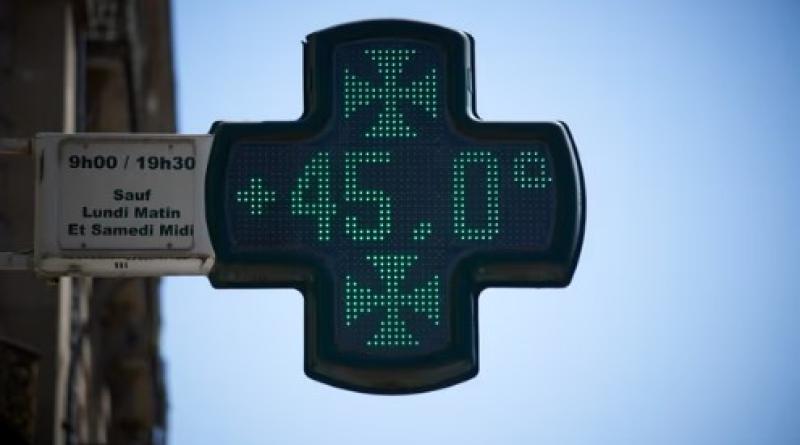Heat denial: influencers question validity of high temperatures

Tweet viewed millions of times claimed ground temperature was being confused with air temperature
As thermometers creep upwards, it has become harder and harder to deny the reality of the climate crisis. Some, however, are questioning whether temperatures are being measured properly in the first place.
In a tweet seen millions of times, the influencer Robin Monotti said in July that media outlets were repeating a report from the European Space Agency (ESA) that confused air temperature with ground temperature, which is generally higher.
The GB News presenter Neil Oliver took up the refrain later that month, claiming air temperatures in Europe were not as high as stated by the BBC and others, and had not risen above the 30s. He said the higher figures were ground temperatures which could not be compared with the standard measurement temperature.
The international standard approach for meteorologists is to measure shade temperature inside a purpose-built, white-slatted box known as a Stevenson screen which is positioned at a height of 2 metres to minimise the effects of the ground, and which has a backup thermometer to confirm the main instrument’s accuracy. The Met Office specifies a minimum height of 1.25 metres. According to Dr Karsten Haustein, a climate scientist at Leipzig University, the difference between those heights “would be minimal or nonexistent”.
While some news outlets had shared the ESA’s satellite maps showing ground temperature, the BBC quickly refuted Oliver’s argument, noting that its weather reports used air temperatures measured by meteorologists in line with international standards. But the complaints have continued to echo across social media from a number of different directions.
Another argument increasingly doing the rounds is that some instruments are not up to World Meteorological Organization (WMO) standards, or not working properly. One blogger challenged the record-breaking reading at one site in Sardinia, saying the instrument involved was “poorly sited and maintained”. Sardinia’s Regional Agrometeorological Service looked into the weather stations involved and confirmed they were operated according to WMO standards.
Commentators have also repeatedly attacked the weather maps themselves, saying the colours have been changed to make them more alarmist. Monotti calls them “psychedelic coloured psyops”, while another Twitter user posted a heatwave map of Spain with the caption: “Now they have to colour the map as if we were in hell itself.”
It is true that the UK’s Met Office has changed the colour scheme of its temperature maps in recent years, and the more vivid colours are intended to make the maps easier for those with colour-blindness and generally simpler to interpret.
But in other cases, people put maps from different European sources side by side to give the misleading impression that new, alarming colour schemes had been adopted. Versions of the claim have circulated in English, German, Spanish, French, Hungarian and Polish.
Asked to comment, Monotti reiterated that one of the Sardinian weather stations was not to WMO standards. “In the case of the Jerzu temperatures quoted, the station was positioned near a road, and photos of it showed overgrown wild grass growing very high right below it, which can trap heat and therefore is not according to WMO regulations.”
Monotti added that the most important factors for current warming were the eruption of the Hunga Tonga-Hunga Ha’apai underwater volcano in January 2022, the Schwabe solar cycle of 11 years, and the Eddy solar cycle of 1,000 years.
He said: “CO2 has negligible effects on climate, as the main greenhouse gas is water vapour, accounting to 95% of all greenhouse gases and having the greatest effect on climate, and the cloud cover is the Earth’s self-regulating climate valve, and is what determines how much solar radiation reaches the surface.”
These statements do not accord with the reports published by the Intergovernmental Panel on Climate Change, which is composed of the world’s leading climate scientists.
GB News did not respond to a request for comment.
Bob Ward, from the LSE’s Grantham Institute on Climate, said: “Yes, this form of denial became very visible during the summer heat crisis in Europe earlier this summer.
“This form of denial is particularly pernicious because it misleads people about the clear dangers that extreme heat poses to people, directly and through the higher risk of wildfires. It is another example of how climate change deniers sacrifice the public interest in pursuit of their extreme political agenda.
“On 13 July, the European Space Agency released satellite data about land surface temperatures in Europe. These were in addition to the standard temperature measurements recorded by meteorological agencies that are taken 2 metres above the land surface. Land surface temperatures are typically much higher than air temperatures. When the agency saw that confusion was being spread about the two different sets of measurements, they issued a clarifying statement on 18 July.”
The statement can be accessed here.
Ward said: “Several climate change deniers falsely claimed that the agency had replaced air temperature measurements with land surface measurements in order to exaggerate the impacts of the heatwave. This is patently untrue.”





